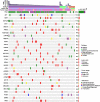A comprehensive analysis of somatic alterations in Chinese ovarian cancer patients
- PMID: 33432021
- PMCID: PMC7801677
- DOI: 10.1038/s41598-020-79694-0
A comprehensive analysis of somatic alterations in Chinese ovarian cancer patients
Abstract
Ovarian cancer is one of the most common cancers in women and is often diagnosed as advanced stage because of the subtle symptoms of early ovarian cancer. To identify the somatic alterations and new biomarkers for the diagnosis and targeted therapy of Chinese ovarian cancer patients, a total of 65 Chinese ovarian cancer patients were enrolled for detection of genomic alterations. The most commonly mutated genes in ovarian cancers were TP53 (86.15%, 56/65), NF1 (13.85%, 9/65), NOTCH3 (10.77%, 7/65), and TERT (10.77%, 7/65). Statistical analysis showed that TP53 and LRP1B mutations were associated with the age of patients, KRAS, TP53, and PTEN mutations were significantly associated with tumor differentiation, and MED12, LRP2, PIK3R2, CCNE1, and LRP1B mutations were significantly associated with high tumor mutational burden. The mutation frequencies of LRP2 and NTRK3 in metastatic ovarian cancers were higher than those in primary tumors, but the difference was not significant (P = 0.072, for both). Molecular characteristics of three patients responding to olapanib supported that BRCA mutation and HRD related mutations is the target of olaparib in platinum sensitive patients. In conclusion we identified the somatic alterations and suggested a group of potential biomarkers for Chinese ovarian cancer patients. Our study provided a basis for further exploration of diagnosis and molecular targeted therapy for Chinese ovarian cancer patients.
Conflict of interest statement
The authors declare no competing interests.
Figures




Similar articles
-
Germline and somatic mutations of multi-gene panel in Chinese patients with epithelial ovarian cancer: a prospective cohort study.J Ovarian Res. 2019 Aug 31;12(1):80. doi: 10.1186/s13048-019-0560-y. J Ovarian Res. 2019. PMID: 31472684 Free PMC article.
-
Next-generation sequencing-based genomic profiling analysis reveals novel mutations for clinical diagnosis in Chinese primary epithelial ovarian cancer patients.J Ovarian Res. 2019 Feb 20;12(1):19. doi: 10.1186/s13048-019-0494-4. J Ovarian Res. 2019. PMID: 30786925 Free PMC article.
-
Targeted Genomic Profiling Reveals Recurrent KRAS Mutations in Mesonephric-like Adenocarcinomas of the Female Genital Tract.Am J Surg Pathol. 2018 Feb;42(2):227-233. doi: 10.1097/PAS.0000000000000958. Am J Surg Pathol. 2018. PMID: 28984674
-
Current strategies for the targeted treatment of high-grade serous epithelial ovarian cancer and relevance of BRCA mutational status.J Ovarian Res. 2019 Jan 28;12(1):9. doi: 10.1186/s13048-019-0484-6. J Ovarian Res. 2019. PMID: 30691488 Free PMC article. Review.
-
The current landscape of molecular profiling in the treatment of epithelial ovarian cancer.Gynecol Oncol. 2021 Jan;160(1):333-345. doi: 10.1016/j.ygyno.2020.09.043. Epub 2020 Oct 11. Gynecol Oncol. 2021. PMID: 33055011 Review.
Cited by
-
The Prognostic Significance of Tumor-Infiltrating Lymphocytes, PD-L1, BRCA Mutation Status and Tumor Mutational Burden in Early-Stage High-Grade Serous Ovarian Carcinoma-A Study by the Spanish Group for Ovarian Cancer Research (GEICO).Int J Mol Sci. 2023 Jul 6;24(13):11183. doi: 10.3390/ijms241311183. Int J Mol Sci. 2023. PMID: 37446361 Free PMC article.
-
Characteristics of homologous recombination repair pathway genes mutation in ovarian cancers.Cancer Innov. 2022 Sep 20;1(3):220-228. doi: 10.1002/cai2.27. eCollection 2022 Oct. Cancer Innov. 2022. PMID: 38089758 Free PMC article.
-
Screening of differentially expressed miRNAs during osteogenic/odontogenic differentiation of human dental pulp stem cells exposed to mechanical stress.Am J Transl Res. 2021 Oct 15;13(10):11126-11143. eCollection 2021. Am J Transl Res. 2021. PMID: 34786047 Free PMC article.
-
An integrated machine learning-based model for joint diagnosis of ovarian cancer with multiple test indicators.J Ovarian Res. 2024 Feb 20;17(1):45. doi: 10.1186/s13048-024-01365-9. J Ovarian Res. 2024. PMID: 38378582 Free PMC article.
-
APOBEC3A drives ovarian cancer metastasis by altering epithelial-mesenchymal transition.JCI Insight. 2025 Mar 10;10(5):e186409. doi: 10.1172/jci.insight.186409. JCI Insight. 2025. PMID: 40059825 Free PMC article.
References
-
- Monk BJ, Coleman RL. Changing the paradigm in the treatment of platinum-sensitive recurrent ovarian cancer: from platinum doublets to nonplatinum doublets and adding antiangiogenesis compounds. Int. J. Gynecol. Cancer Off. J. Int. Gynecol. Cancer Soc. 2009;19(Suppl 2):S63–67. doi: 10.1111/IGC.0b013e3181c104fa. - DOI - PubMed
Publication types
MeSH terms
Substances
LinkOut - more resources
Full Text Sources
Other Literature Sources
Medical
Research Materials
Miscellaneous

